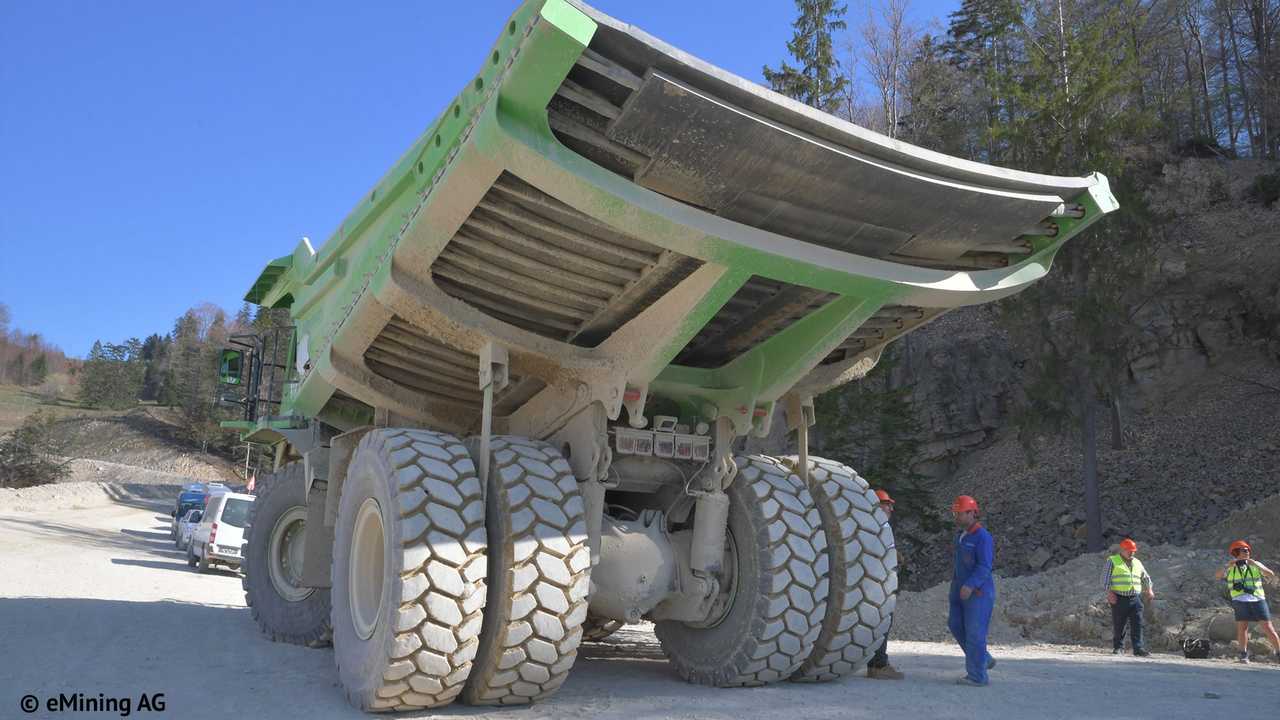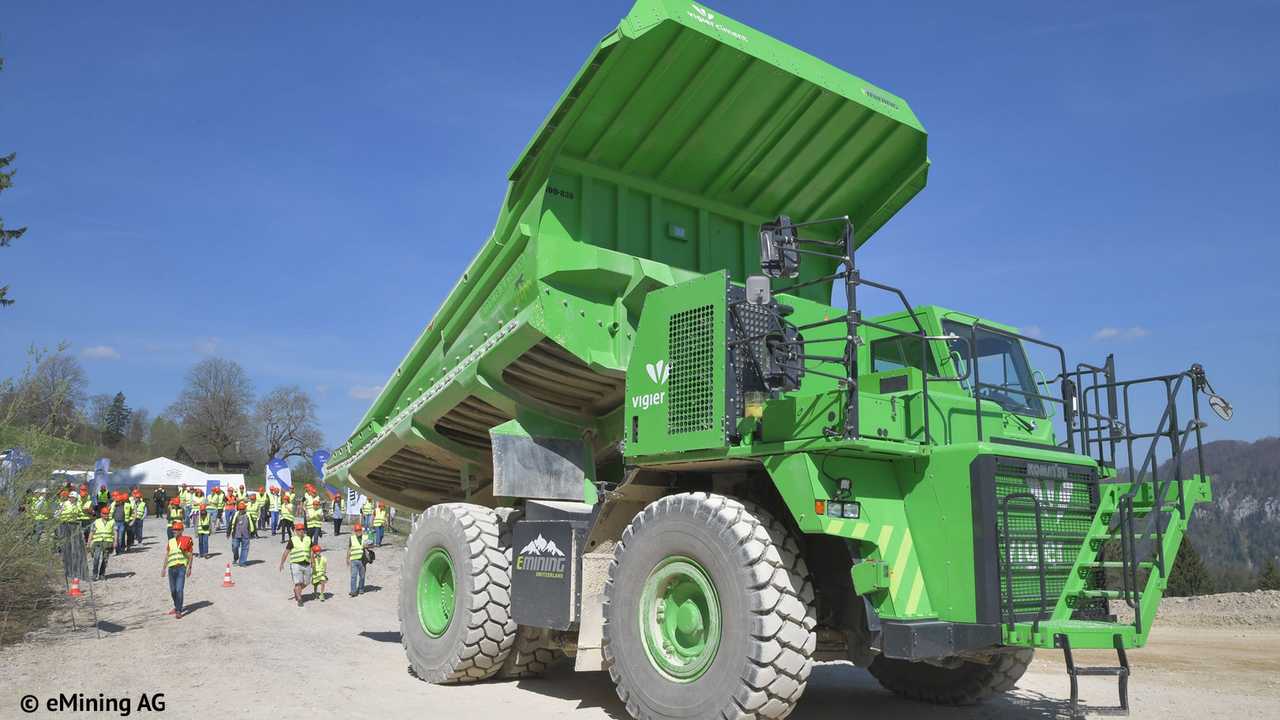Environment & Energy
Related: About this forumWTH? 110-ton electric vehicle dump truck never needs recharging.

A quarry in Biel, Switzerland, is operating the world's largest electric vehicle, a 110-ton dump truck, to haul lime and marl off the side of a mountain to a cement factory. Perhaps best of all, it consumes no energy doing it.
How is that possible, you ask?
The dump truck, at 45 tons, ascends the 13-percent grade and takes on 65 tons of ore. With more than double the weight going back down the hill, the beast's regenerative braking system recaptures more than enough energy to refill the charge the eDumper used going up.
The Elektro Dumper—eDumper for short—made by Kuhn Schweitz, is based on a Komatsu HB 605-7: 30 feet long, 14 feet wide, and 14 feet tall. The tires are six feet high, and the dump bed reaches to more than 28 feet, fully raised.
<snip>
Marking that trip around 20 times a day, Kuhn Schweitz says the eDumper produces 200 kwh of surplus energy every day, or 77 megawatt-hours a year. A typical dump truck uses between 11,000 and 22,000 gallons of diesel fuel a year. That saves up to 196 metric tons of global-warming carbon-dioxide gas a year. - Green Car Reports
Brilliant! A truck that pays for itself.

onecaliberal
(32,864 posts)House of Roberts
(5,177 posts)(Kinetic Energy Recovery System),I knew it was just a matter of time until a practical application for it showed up.
hlthe2b
(102,293 posts)Cleetus Ford
(4 posts)It might even make coal more affordable.
Response to Cleetus Ford (Reply #5)
hlthe2b This message was self-deleted by its author.
marble falls
(57,106 posts)packman
(16,296 posts)pangaia
(24,324 posts)abqtommy
(14,118 posts)it's going up and down!
pangaia
(24,324 posts)progree
(10,909 posts)thus capturing the change in potential energy of a mass going from higher elevation to a lower one.
It is an empty 45 ton truck going uphill, and a 110 ton truck (including the ore) going downhill.
If it had to move 110 tons uphill, it will take a lot of energy to do that -- more than the energy captured by the regenerative braking in moving that same mass downhill because of losses caused by friction and because of less-than-100% conversion efficiency.
Won't work to haul the big mass up and down and up and down etc.. (or down and up and down and up etc.) unless the ending point is lower in elevation than the starting point -- lower enough to make up for the friction and conversion losses.
ffr
(22,670 posts)The truck doesn't haul uphill nor does the story say anything of the matter, so why bring it up? The only thing you are doing is distracting from the point of the story with your Straw Man fallacies: If... Won't...
FACT: this truck never has to recharge.
progree
(10,909 posts)8. Not to worry! If it's hauling out of a mine or quarry then it's going up and down!
I interpreted this as maybe meaning that this is something that will work as long as it is working on hilly terrain, and that it would work if it's hauling ore up, like up out of a mine (which is usually underground). Or up out of a quarry, which is often a pit in the ground. And it said hauling ... "up" first.
So I was just clarifying that it doesn't work only because there are hills that one can go up and down on. But rather it works because the ore is ultimately being moved to a lower end point than the starting point (It took me awhile to think this through, and I thought maybe I wasn't the only one.).
(To clarify my remark further, it WILL work to haul it UP out of a mine or quarry as long as it is ultimately hauled to a lower ending point -- again lower enough to make up for friction and conversion efficiency losses)
I think it's great, I really do, that it works for this application, and kudos to electric vehicle technology and battery technology for making this work and for whoever decided to use an electric vehicle for this purpose to save energy and money. I look forward to more non-obvious ways (non-obvious to me anyway) that these new technologies will substantially help us.
I had no intention whatsoever to dis on your OP or the concept. I very much appreciate both. It expanded my range of thinking.
NNadir
(33,525 posts)I knew the 2nd law of Thermoynamics just couldn't be real.
All we have to do now is build a few billion mining trucks, build big holes and everything will be all better.
Take that Boltzman!
jmowreader
(50,560 posts)This uses kinetic energy from going downhlll, so it's fine.
NNadir
(33,525 posts)jmowreader
(50,560 posts)It goes up the hill empty. It comes down full. It has regenerative brakes like you find on a Tesla or a hybrid car, just a lot bigger.
Gravity alone will pull the truck downhill, but you've got to use the brakes to keep it to a reasonable speed and to stop it at the unloading point. The brakes they're using generate enough electricity to drive the truck back to the loading point.
NNadir
(33,525 posts)Never mind.
I really don't want to know; I just realized where I'm writing.
Just for the record, however, I have heard, so as to believe it that the patent office requires working models for perpetual motion machines.
progree
(10,909 posts)Last edited Mon Aug 26, 2019, 08:58 PM - Edit history (1)
going as long as there is stuff to move to a sufficiently lower elevation (leaving aside maintenance issues and that the driver needs food and other energy to function). And yes, I know it takes energy to make new battery packs and new trucks and new drivers.
The only claim being made is that the truck -- with its regenerative braking system and battery -- capture enough of the potential energy change of a 110 ton mass (the truck with ore) going downhill -- enough to propel a 45 ton mass (the empty truck) back up the hill. With some energy left over to spare.
Just like a hydroelectric plant can keep making electricity as long as there's water falling from a higher elevation to a lower one (leaving aside maintenance issues and that it won't last forever).
Back to the truck -- however, since the surplus energy is apparently being wasted (the article says nothing about the surplus being used for anything), the whole system is less than energy neutral, since any energy used in maintenance, building new trucks, keeping the driver alive and working, etc. etc. needs to come from somewhere.
captain queeg
(10,208 posts)Not many situations where this would work. No doubt a significant initial investment that had to be justified up front.
Hermit-The-Prog
(33,356 posts)That's before you get to the differences in maintenance costs between internal combustion engines (and support systems) and electric motors. All the emissions reduction is just icing on the cake.
NickB79
(19,253 posts)All the other machinery onsite uses massive amounts of energy from fossil fuels to extract the ore in the first place. This ore then acts as a potential energy store that's consumed when transported downhill. Without this energy input, the truck would deplete it's battery within a few hours.
So, very cool in this specific situation, but not really applicable to other uses so much.